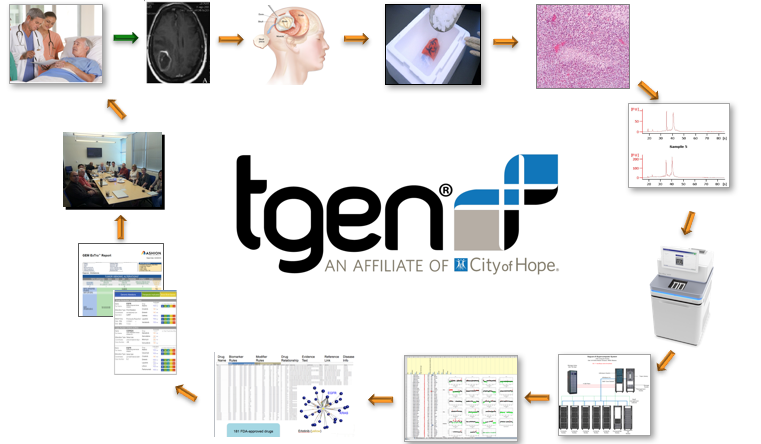
Advances in genome sequencing technologies and the growing availability of clinical and other health data present an opportunity to make targeted therapies a reality for patients – a true testament that the best of times are on the horizon for the field of precision medicine.
Leading cancer center, City of Hope, is paving the way with ambitious goals to sequence every cancer patient that walks through their doors. This ultimately will accelerate the discovery of targeted therapies and deliver personalized and high quality care. At ASHG, we invited Linda Bosserman, MD, Assistant Clinical Professor at City of Hope, and Jonathan Keats, PhD, Director of Bioinformatics at the Translational Genomics Research Institute (TGen) and Scientific Director, Briskin Center for Multiple Myeloma at City of Hope, to discuss how they are leading the charge to deliver on this promise.
Dr. Bosserman and Dr. Keats alike believe that the way to achieve these ambitious goals is to un-silo data stores and bring all data types into one view so the physician can be as informed as possible on the diagnostic details to facilitate discussions of the most effective treatment options in shared decision making with the patient.
Precision medicine in practice
To achieve the goals set forth by City of Hope, the organization is leveraging DNAnexus’ Apollo Platform to integrate their clinical-rich enterprise data warehouse with genomics, multi-omics, and imaging data. With harmonized datasets, they will be able to seamlessly conduct genome-wide association studies and other analyses to look at the relationship between genotype, phenotype and clinical outcomes.
To diagnose and then present a patient with therapy options, clinicians need access to a myriad of data types. Dr. Bosserman spoke about the need for accurate and complete medical records to determine patient demographics, medications, immunizations, family history, and cancer data by episode, including stage, tumor features and mutations at diagnosis and progression. Only when physicians understand the full scope of the patient journey, can they weigh the costs and benefits of selected treatments and make suggestions for the best therapies or clinical trials to the patient. Breaking down data silos and making this detailed information available to the clinician, especially as we gain the capacity to add validated decision support information is crucial to deliver the most precise and personalized level of cancer care.
Precision medicine at the bedside – wherever that may be
City of Hope is an independent, cutting-edge cancer research and treatment center located near Los Angeles, CA and has expanded to provide their state-of-the-art targeted therapies to patients at 31 clinical network locations throughout Southern California. City of Hope also works with employers across the country and international physicians and patients to provide access to its internationally renowned cancer expertise by written consultations, coordination of care with their primary clinicians, telemedicine or in-person visits to the campus.
Dr. Keats joined us from TGen, a City of Hope affiliate in Phoenix, Arizona, where they are building a genomics-enabled precision medicine model. TGen is breaking away from the traditional approach of evidence-based medicine using percentages to determine the best treatment option for generalized patients with a certain phenotype. Instead, they are working to determine the most precise treatment path based on what will work for that specific patient‘s tumor type using their comprehensive genomic analysis model and translating that to clinical care.
As a first step, Dr. Keats and his research team at TGen conduct tumor-normal whole exome and tumor RNA sequencing. Analysis is conducted with an internally configured and validated analysis pipeline with a mixture of open-source, commercial, and internal tools to identify single-nucleotide polymorphisms, copy number and structural variations, gene fusions and transcript variations. The team measures DNA and RNA changes for >20,000 genes and applies gene-drug matching to identify potential therapeutic options. Treatment is then recommended by a tumor board based on genomic characteristics of each patient’s tumor.

Dr. Bosserman and Dr. Keats shared similar methodologies for how they are leveraging rich and varied data sources to gain insights, yet medical centers and clinical research labs continue to face hurdles to translate discoveries into clinical practice. To achieve actionable insights for delivery of precision clinical care, researchers must be equipped with the best possible technologies to determine correlations between real-world clinical and phenotype data and genomic and multi-omics data to better understand the molecular mechanisms of disease.
At DNAnexus, we are committed to solving this problem by bringing together people from different disciplines who are approaching this issue from various angles and supporting initiatives like these that seek to access and explore heterogeneous datasets, make meaningful discoveries faster, and deliver better and more targeted patient care.
See how DNAnexus Apollo can accelerate your discovery with a molecular precision medicine hub for advanced data harmonization and exploration.

.png)
.png)
.png)